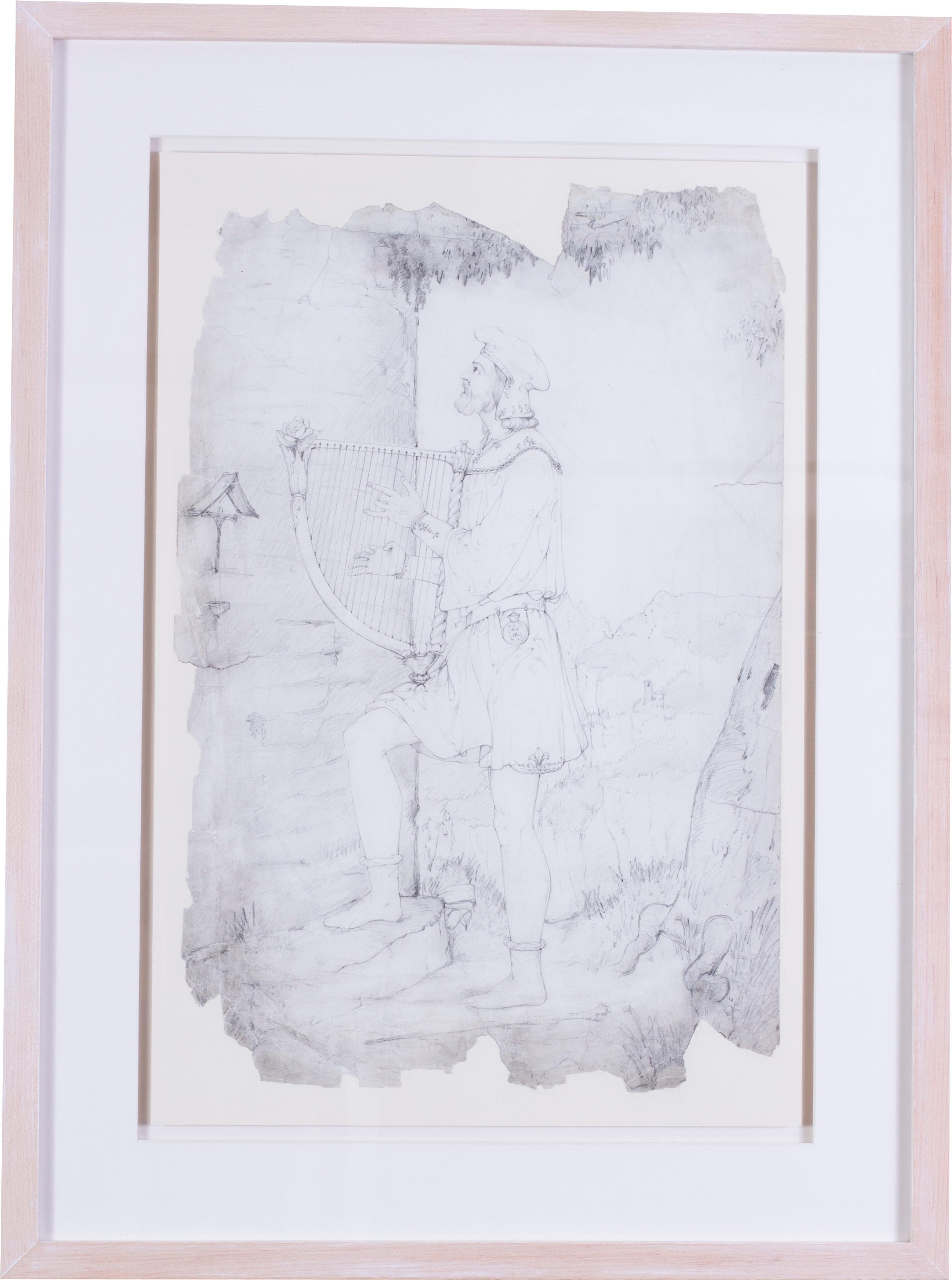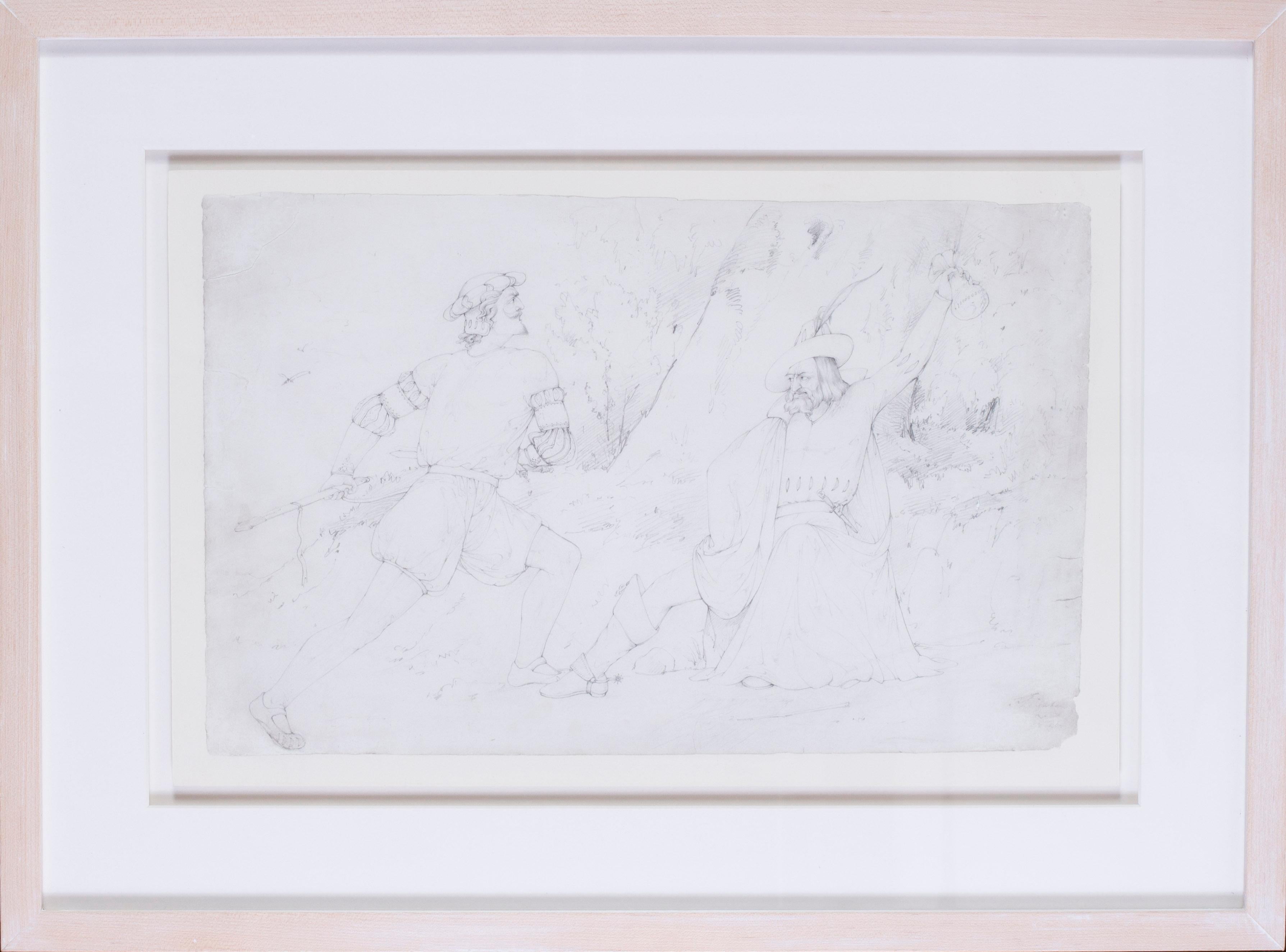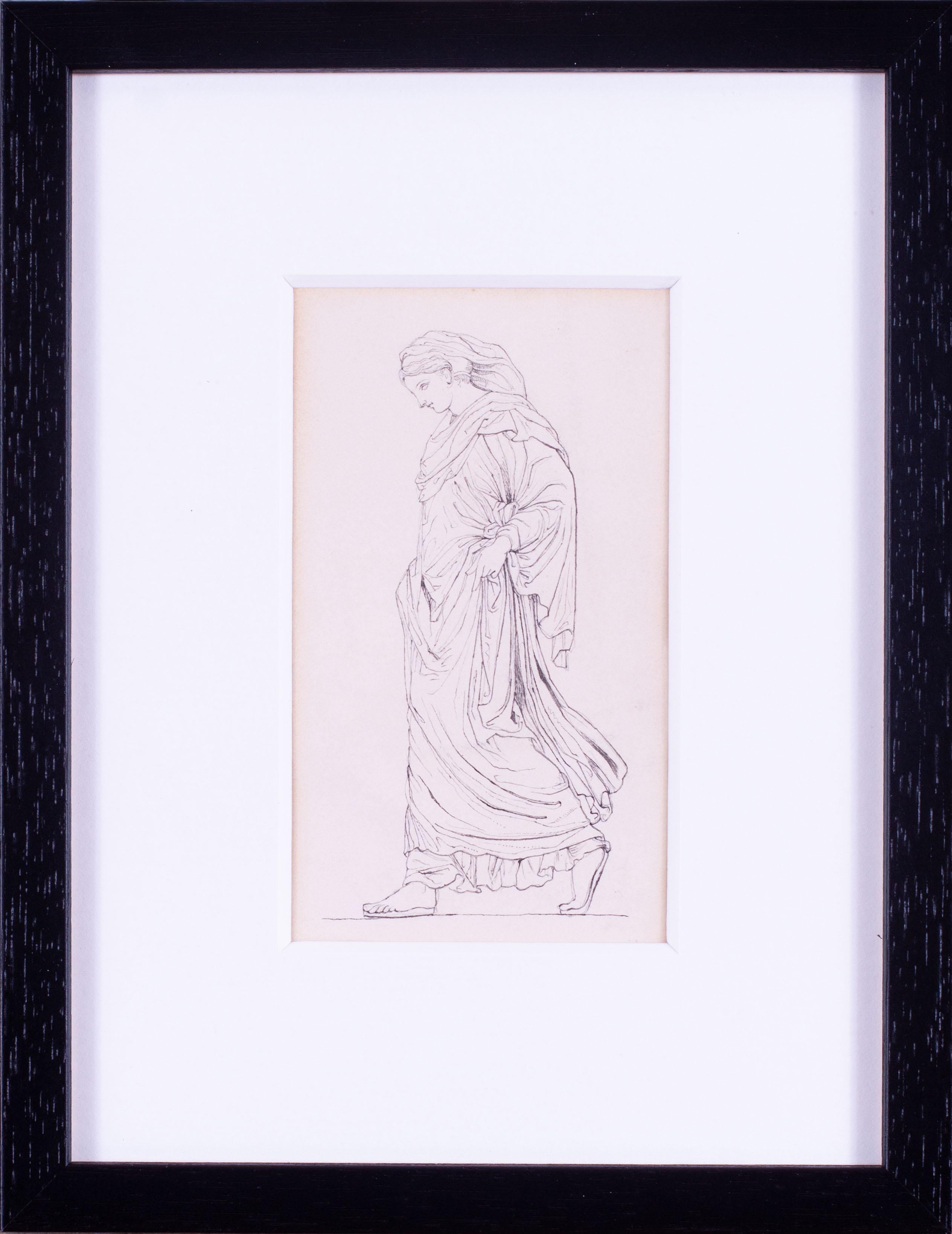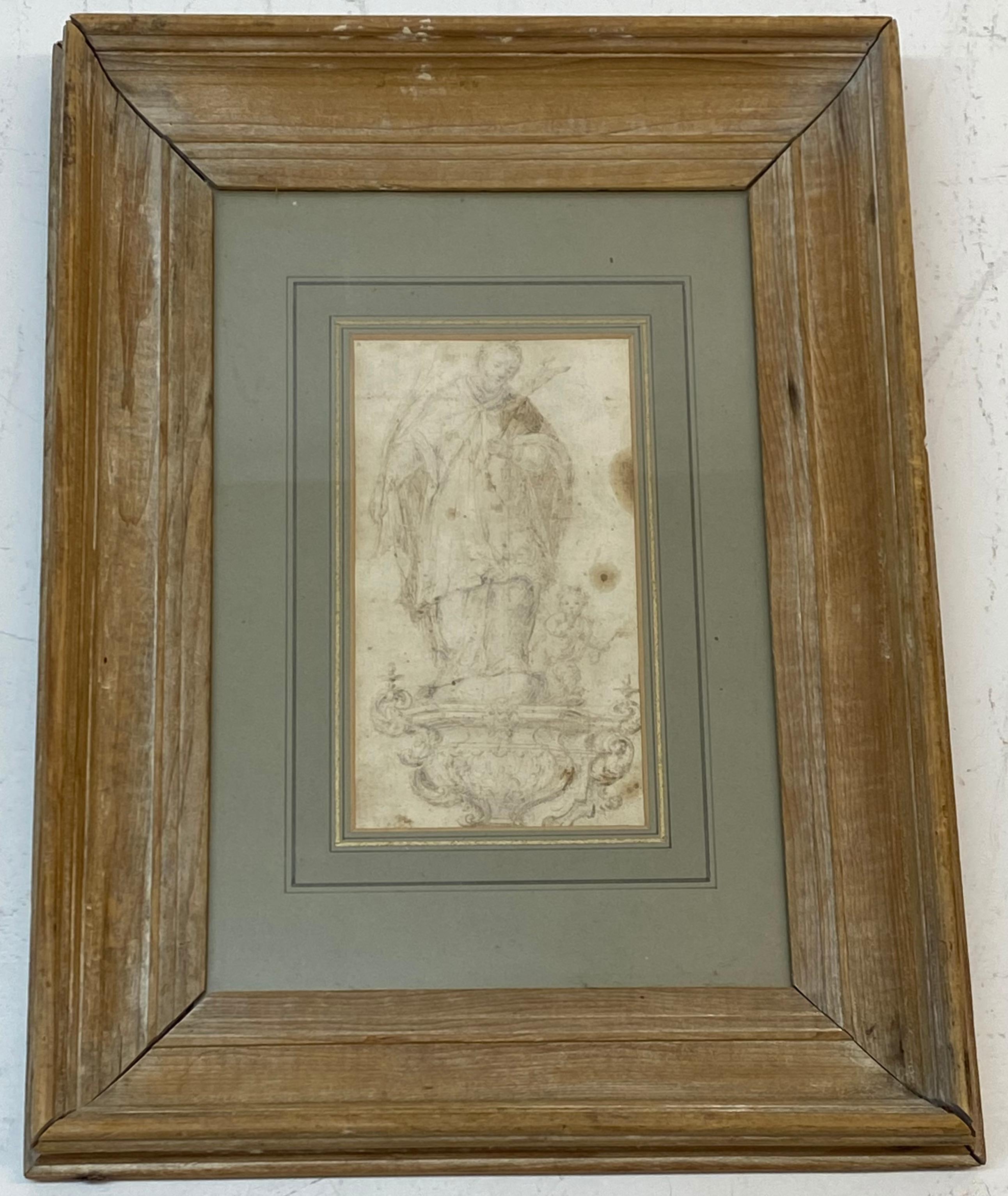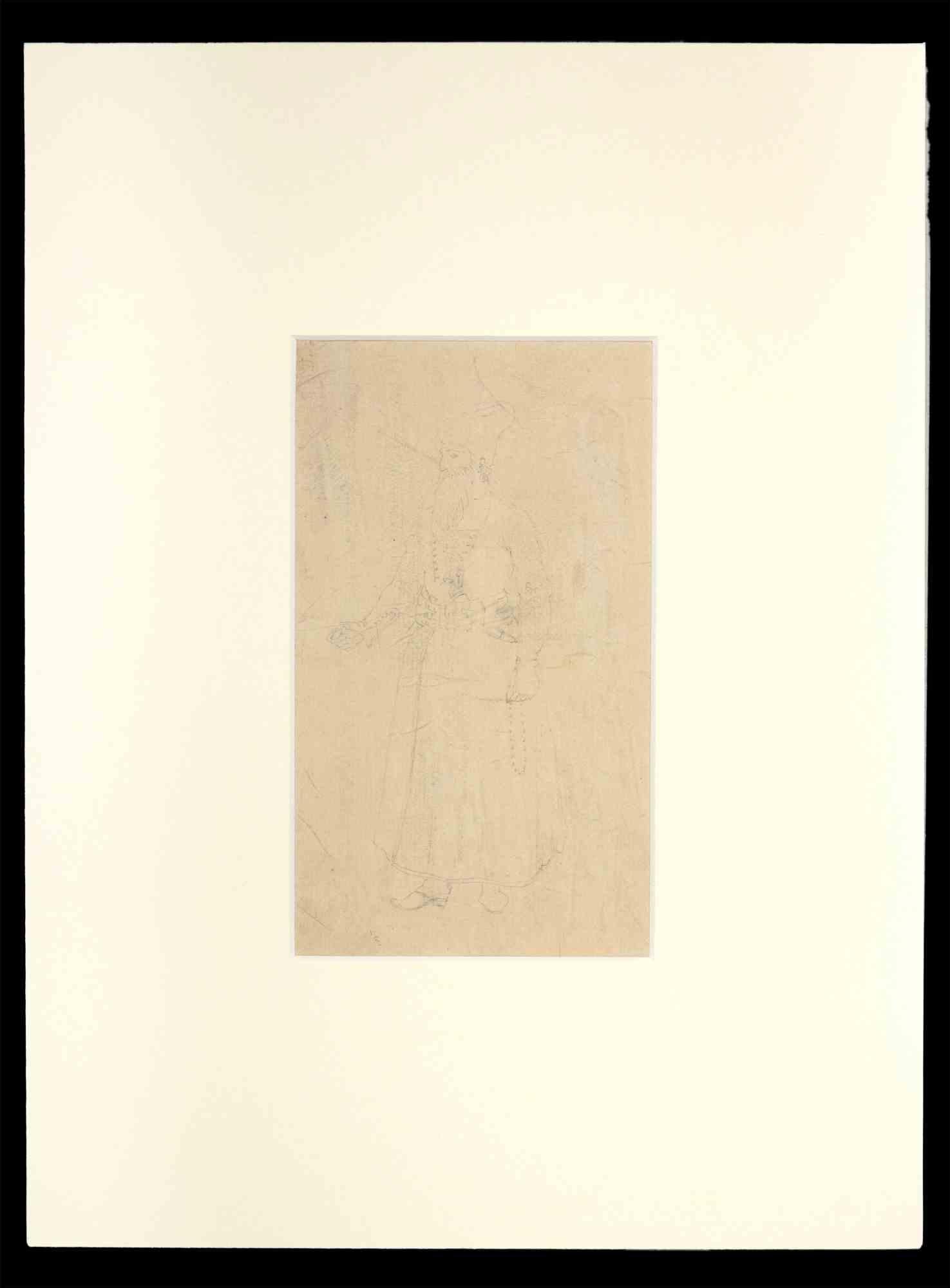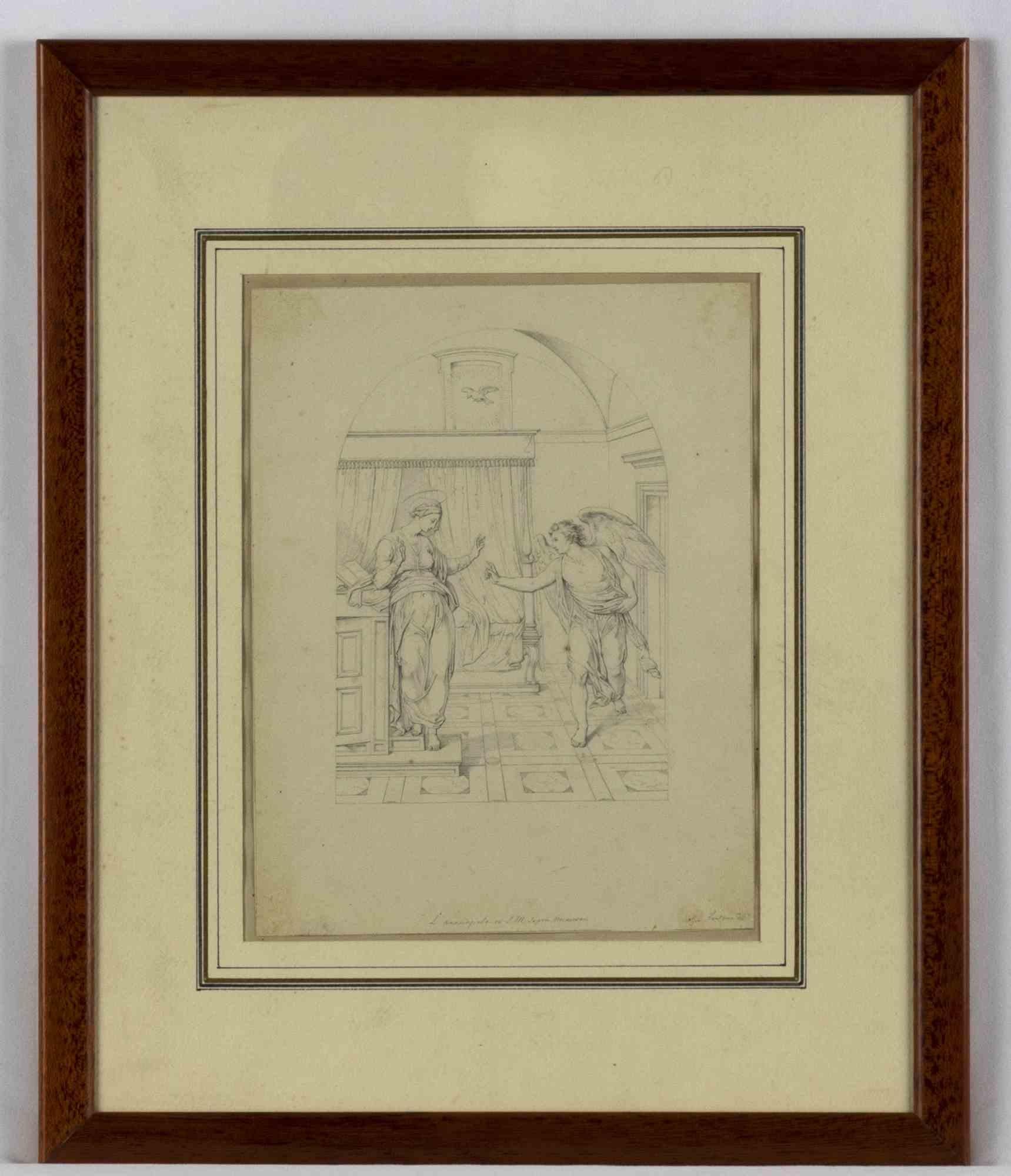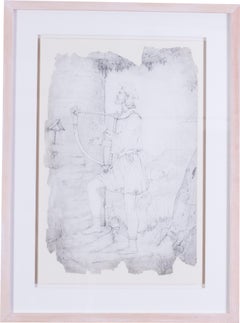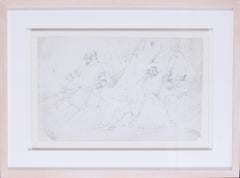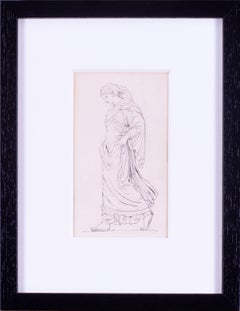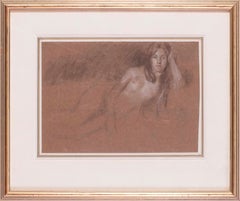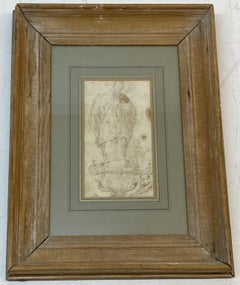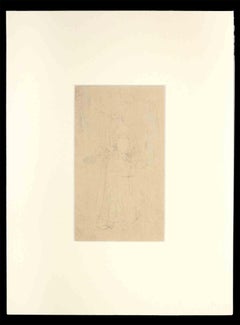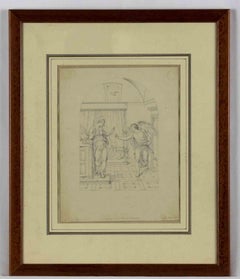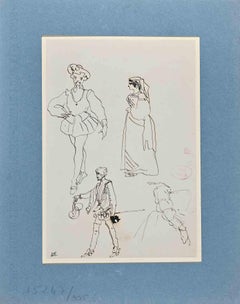Items Similar to Pre-Raphaelite, early 19th Century drawing by the British artist Lord Leighton
Want more images or videos?
Request additional images or videos from the seller
1 of 11
Frederic LeightonPre-Raphaelite, early 19th Century drawing by the British artist Lord Leighton
$5,647.58
£4,100
€4,833.19
CA$7,766.27
A$8,638.09
CHF 4,520.99
MX$105,356.19
NOK 56,807.89
SEK 53,435.15
DKK 36,075.05
About the Item
Lord Frederick Leighton (British, 1830-1896)
A Medieval Allegory
pencil on paper
the fragment measures approx. 19.1/2 x 13 in.
(49.5 x 33 cm.)
Provenance: Gifted by Leighton to his cousin Edith Emily Jellicorse, nee Garnham, and thence by descent.
We would like to thank Daniel Robins, the curator at Leighton House for the authenticating this work in full.
Daniel has suggested this study would have been executed when Leighton was studying in Frankfurt
Leighton was born in Scarborough to Augusta Susan and Dr. Frederic Septimus Leighton. He received his artistic training on the European continent, first from Eduard von Steinle and then from Giovanni Costa. According to Daniel Robbins, the curator at Leighton House, This drawing comes from the time Leighton studied under Eduard von Steinle. He then studied at the Accademia di Belle Arti in Florence. From 1855 to 1859 he lived in Paris, where he met Ingres, Delacroix, Corot and Millet. In 1860, he moved to London, where he associated with the Pre-Raphaelites. In 1864 he became an associate of the Royal Academy and in 1878 he became its President (1878–96). American art critic Earl Shinn claimed at the time that "Except Leighton, there is scarce any one capable of putting up a correct frescoed figure in the archway of the Kensington Museum." His paintings represented Britain at the great 1900 Paris Exhibition. Leighton was knighted at Windsor in 1878 and was created a baronet, of Holland Park Road eight years later. He was the first painter to be given a peerage. Leighton remained a bachelor and rumours of him having an illegitimate child with one of his models, in addition to the supposition that Leighton may have been a homosexual, continue to be debated. On his death his barony was extinguished after existing for only a day; this is a record in the Peerage. His house in Holland Park, London has been turned into a museum. It contains many of his drawings and paintings, as well as some of his former art collection including a painting dedicated to Leighton by Sir John Everett Millais. The house also features many of Leighton's inspirations, including his collection of Iznik tiles. Its centrepiece is the magnificent Arab Hall. Leighton was an enthusiastic volunteer soldier, enrolling with the first group to join the 38th Middlesex (Artists') Rifle Volunteer Corps (later to be known as the Artists Rifles) on 5 October 1860. The painter James Whistler famously described the then, Sir Frederic Leighton, the commanding officer of the Artists Rifles, as the: “Colonel of the Royal Academy and the President of the Artists Rifles – aye, and he paints a little!" At his funeral, on 3 February 1896, his coffin was carried into St Paul's Cathedral, past a guard of honour formed by the Artists Rifles.
- Creator:Frederic Leighton (1830 - 1896, British)
- Dimensions:Height: 19.5 in (49.53 cm)Width: 13 in (33.02 cm)Depth: 1 in (2.54 cm)
- Medium:
- Movement & Style:
- Period:
- Condition:Recently restored. The edges are uneven, stabilised on paper in a pop out frame with a separate mount behind glass in limed wood frame.
- Gallery Location:Petworth, GB
- Reference Number:1stDibs: LU540313099792
About the Seller
4.9
Platinum Seller
Premium sellers with a 4.7+ rating and 24-hour response times
Established in 2010
1stDibs seller since 2017
272 sales on 1stDibs
Typical response time: 3 hours
- ShippingRetrieving quote...Shipping from: Petworth, United Kingdom
- Return Policy
Authenticity Guarantee
In the unlikely event there’s an issue with an item’s authenticity, contact us within 1 year for a full refund. DetailsMoney-Back Guarantee
If your item is not as described, is damaged in transit, or does not arrive, contact us within 7 days for a full refund. Details24-Hour Cancellation
You have a 24-hour grace period in which to reconsider your purchase, with no questions asked.Vetted Professional Sellers
Our world-class sellers must adhere to strict standards for service and quality, maintaining the integrity of our listings.Price-Match Guarantee
If you find that a seller listed the same item for a lower price elsewhere, we’ll match it.Trusted Global Delivery
Our best-in-class carrier network provides specialized shipping options worldwide, including custom delivery.More From This Seller
View AllAn early 19th Century drawing by the British pre-Raphaelite artist Lord Leighton
By Frederic Leighton
Located in Petworth, West Sussex
Lord Frederick Leighton (British, 1830-1896)
A very early study of a Medieval Minstrel
pencil on paper
the fragment measures approx. 19.1/2 x 13 in.
(49.5 x 33 cm.)
Provenance: Gifted by Leighton to his cousin Edith Emily Jellicorse, nee Garnham, and thence by descent.
We would like to thank Daniel Robins, the curator at Leighton House for the authenticating this work in full.
Daniel has suggested this study would have been executed when Leighton was studying in Frankfurt
Leighton was born in Scarborough to Augusta Susan and Dr. Frederic Septimus Leighton. He received his artistic training on the European continent, first from Eduard von Steinle and then from Giovanni Costa. According to Daniel Robbins, the curator at Leighton House, This drawing comes from the time Leighton studied under Eduard von Steinle. He then studied at the Accademia di Belle Arti in Florence. From 1855 to 1859 he lived in Paris, where he met Ingres, Delacroix, Corot and Millet.
In 1860, he moved to London, where he associated with the Pre-Raphaelites. In 1864 he became an associate of the Royal Academy and in 1878 he became its President (1878–96). American art critic Earl Shinn claimed at the time that "Except Leighton, there is scarce any one capable of putting up a correct frescoed figure in the archway of the Kensington Museum." His paintings represented Britain at the great 1900 Paris Exhibition.
Leighton was knighted at Windsor in 1878 and was created a baronet, of Holland Park Road eight years later. He was the first painter to be given a peerage.
Leighton remained a bachelor and rumours of him having an illegitimate child with one of his models, in addition to the supposition that Leighton may have been a homosexual, continue to be debated. On his death his barony was extinguished after existing for only a day; this is a record in the Peerage. His house in Holland Park, London has been turned into a museum. It contains many of his drawings and paintings, as well as some of his former art collection including a painting dedicated to Leighton by Sir John Everett Millais. The house also features many of Leighton's inspirations, including his collection of Iznik tiles. Its centrepiece is the magnificent Arab Hall.
Leighton was an enthusiastic volunteer soldier, enrolling with the first group to join the 38th Middlesex (Artists') Rifle Volunteer Corps (later to be known as the Artists Rifles...
Category
19th Century Pre-Raphaelite Figurative Drawings and Watercolors
Materials
Paper, Pencil
Lord Frederick Leighton drawing, British pre-Raphaelite, original
By Frederic Leighton
Located in Petworth, West Sussex
Lord Frederick Leighton (British, 1830-1896)
Apprehending a thief
pencil on paper
the fragment measures approx. 17.1/3 x 11in. (44 x 28cm.)
signed ‘F Leighton’ (lower right)
Provenance: Gifted by Leighton to his cousin Edith Emily Jellicorse, nee Garnham, and thence by descent
We would like to thank Daniel Robins, the curator at Leighton House for the authenticating this work in full.
Daniel has suggested this study would have been executed when Leighton was studying in Frankfurt
Leighton was born in Scarborough to Augusta Susan and Dr. Frederic Septimus Leighton. He received his artistic training on the European continent, first from Eduard von Steinle and then from Giovanni Costa. According to Daniel Robbins, the curator at Leighton House, This drawing comes from the time Leighton studied under Eduard von Steinle. He then studied at the Accademia di Belle Arti in Florence. From 1855 to 1859 he lived in Paris, where he met Ingres, Delacroix, Corot and Millet. In 1860, he moved to London, where he associated with the Pre-Raphaelites. In 1864 he became an associate of the Royal Academy and in 1878 he became its President (1878–96). American art critic Earl Shinn claimed at the time that "Except Leighton, there is scarce any one capable of putting up a correct frescoed figure in the archway of the Kensington Museum." His paintings represented Britain at the great 1900 Paris Exhibition. Leighton was knighted at Windsor in 1878 and was created a baronet, of Holland Park Road eight years later. He was the first painter to be given a peerage. Leighton remained a bachelor and rumours of him having an illegitimate child with one of his models, in addition to the supposition that Leighton may have been a homosexual, continue to be debated. On his death his barony was extinguished after existing for only a day; this is a record in the Peerage. His house in Holland Park, London has been turned into a museum. It contains many of his drawings and paintings, as well as some of his former art collection including a painting dedicated to Leighton by Sir John Everett Millais. The house also features many of Leighton's inspirations, including his collection of Iznik tiles. Its centrepiece is the magnificent Arab Hall. Leighton was an enthusiastic volunteer soldier, enrolling with the first group to join the 38th Middlesex (Artists') Rifle Volunteer Corps (later to be known as the Artists Rifles...
Category
19th Century Pre-Raphaelite Figurative Drawings and Watercolors
Materials
Paper, Pencil
19th Century drawing attributed to John Flaxman of a classical maiden
By John Flaxman
Located in Petworth, West Sussex
Attributed to John Flaxman (British, 1755- 1826)
Study of a classical maiden
Pen and ink on paper
5.1/2 x 3.1/8 in. (14 x 8 cm.)
Category
19th Century Academic Figurative Drawings and Watercolors
Materials
Paper, Ink, Pen
British 19th Century drawing of a nude by Edward Stott
By Edward Stott
Located in Petworth, West Sussex
Edward Stott, ARA (British, 1859 - 1918)
Reclining nude
Pastel and black crayon
8.1/2 x 12.1/4 in. (21.7 x 31.2 cm.)
Provenance: Abbott and Holder, London
A few years after its foundation in 1886, a critic referred to the New English Art Club as that Steery, Starry, Stotty. Stotty referred to William Stott of Oldham and Edward William Stott. The four men had in common the love French plein air painting...
Category
19th Century Academic Nude Drawings and Watercolors
Materials
Crayon, Pastel
Signed art deco woodcut, by Edward Gordon Craig 'Army of Fortinbras'
Located in Petworth, West Sussex
Edward Gordon Craig (British, 1872 – 1966)
Army of Fortinbras
Woodcut
Signed with monogram (lower right)
4.3/4 x 8.1/4 in. (12 x 20.8cm.)
A beauti...
Category
20th Century Art Deco Figurative Prints
Materials
Woodcut
1988 pencil drawing by British 20th Century artist William Scott
By William Scott
Located in Petworth, West Sussex
William Scott (British, 1930 – 1989)
Lyrical
Pencil on paper
Signed ‘W Scott’ (lower right), further inscribed and dated ‘October 23 1988 / Lyrical… by William Scott’ (on the reverse...
Category
20th Century Abstract Abstract Drawings and Watercolors
Materials
Paper, Pencil
You May Also Like
17th Century Old Master Drawing
Located in San Francisco, CA
17th Century Old Master Drawing
Old master drawing with figure and putti
Housed in a handsome contemporary wooden frame
Drawing dimensions 4...
Category
17th Century Old Masters Figurative Drawings and Watercolors
Materials
Graphite
Portrait of Man - Original Drawing - Late 19th Century
Located in Roma, IT
Portrait of Man is an original drawing in Pencil realized by an unknown Artist in the 19th Century.
Good Conditions.
The artwork is depicted through soft strokes in a well-balanced...
Category
Late 19th Century Modern Figurative Drawings and Watercolors
Materials
Pencil
L'Annunziata in S. M. - Drawing by Giovanni Fontana - 16th Century
By Giovanni Fontana
Located in Roma, IT
L'Annunziata in S. M. sopra Minerva is an original old master artwork realized by Giovanni Fontana.
Ivory colored sheet attached on an ivory colored cardboard ( cm 35.8 x 26.7)
Bea...
Category
16th Century Old Masters Figurative Drawings and Watercolors
Materials
Paper, Pencil
$4,380 Sale Price
25% Off
Portraits - Drawing on Paper by E. Giraud - Late 19th Century
By Eugène Giraud
Located in Roma, IT
Portrait of Man from behind is an Original Drawing in China Ink realized by Eugène Giraud in the Late 19th Century.
Good conditions.
With stamp.
The delicate and beautiful fine st...
Category
Late 19th Century Modern Figurative Drawings and Watercolors
Materials
Paper
18th to 19th Century "Art Presentation" Old Master Drawing
Located in San Francisco, CA
18th to 19th Century "Art Presentation" Old Master Drawing
Remarkable old master pen, ink and wash drawing of an art presentation
Dimensions 14" wide x 8.5" high
The lightly distr...
Category
Early 19th Century Figurative Drawings and Watercolors
Materials
Ink, Watercolor
1860s Drawing L'Amazon Figurative
By Constantin Ernest Adolphe Hyacinthe Guys
Located in Soquel, CA
Antique pencil and faded watercolor wash portrait titled "L'Amazon" (French, translates "horsewoman") by Constantin Guys (French, 1802-1892), circa 1860...
Category
1860s Victorian Figurative Drawings and Watercolors
Materials
Watercolor, Rag Paper, Pencil
$700 Sale Price
20% Off
More Ways To Browse
19th Century American Artists
Drawing Cathedral
19th Century Artist Model
Pre Raphaelite
Britains Soldiers
British Officer Painting
Painting St Pauls Cathedral
Dutch Watercolor 19th Century
Antique Bachelors
Arab Drawing
Paintings Pre 1900
Used Rifles
Susan Park
British Royal Guard
Art Antique Pre 1900 Paintings
Frederick Childs
John Everett
Antique Rifles
